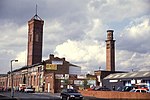Leeds (Whitehall Road) power station
Buildings and structures in LeedsCoal-fired power stations in EnglandDemolished power stations in the United KingdomFormer power stations in England
Leeds power station, also known as Whitehall Road power station, supplied electricity to the city of Leeds and the surrounding area from 1893 to 1965. It was initially built, owned and operated by the Yorkshire House-to-House Electricity Company Limited. Leeds Corporation took over the electricity undertaking in 1898 and generated and distributed electricity until the nationalisation of the British electricity supply industry in 1948. The power station was redeveloped several times to meet increasing demand for electricity.
Excerpt from the Wikipedia article Leeds (Whitehall Road) power station (License: CC BY-SA 3.0, Authors).Leeds (Whitehall Road) power station
Whitehall Quay, Leeds Holbeck Urban Village
Geographical coordinates (GPS) Address Nearby Places Show on map
Geographical coordinates (GPS)
| Latitude | Longitude |
|---|---|
| N 53.795277777778 ° | E -1.5519444444444 ° |
Address
Whitehall Quay
Whitehall Quay
LS1 4HR Leeds, Holbeck Urban Village
England, United Kingdom
Open on Google Maps










